Create The Crust You Crave: The Baking Steel Is The Answer For Home Pizza Baking
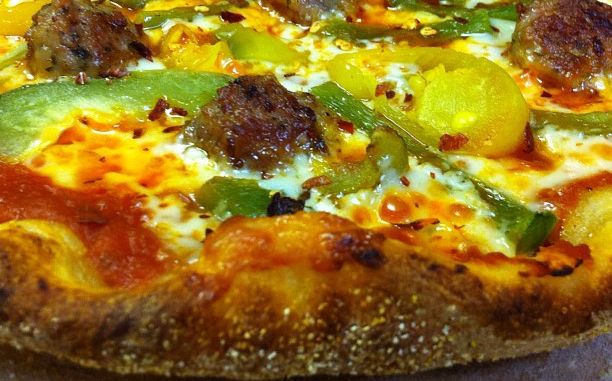
THE PERENNIAL PIZZA PROBLEM OF THE HOME PIZZA CHEF: SOGGY CRUST
Do you like pizza with soggy crust?
I don’t either.
And as a home pizza chef I have spent years trying to perfect not only my dough recipe and my sauce recipe but my baking methodology as well.
WHY WOULD I NEED A BAKING METHODOLOGY?
Because I have a home oven. And home ovens just don’t get hot enough to produce the kind of pizza you find at your favorite pizza parlor.
I remember when baking stones first came out. I got one right away. That was years ago, and I have gone through at least a couple of stones since then. The baking stones really were a step in the right direction. They produced a better crust, and a better pizza. But there were certainly limitations with baking stones, the biggest of which is the hot / cold issue. You can’t put anything cold on a hot stone or it will crack. So, without two or three stones in the house, I had to do baking gymnastics in order to get all of my pizzas baked in a timely manner. My system involved a baking stone and two metal baking trays, one perforated, and the other a deep-dish tray. Using the trays for some of the pizzas would allow the stone too cool a bit so that I could eventually put another pizza on it. Mind you, when I go through the effort to make pizzas at home, I usually make four at a time. That way I cover both dinner and the next day’s breakfast. Or lunch.
Even with that system in place, and giving preference to the pizzas baked on the stone, my crusts still tended to come out soggy or not fully cooked on top. Then, about a year or so ago, a friend of mine recommended that I pre-bake the crusts. Not fully baked, but to bake them in the oven for about 8 minutes or so until the crust is almost cooked. That way, you can prevent the sogginess before adding the sauce and toppings to your pizza. It was a great idea. And I fully subscribed to it. One major problem with this pre-baking method is that it created more work, which thereby demanded even more baking gymnastics on my part.
I wrote about all of this last month in two articles. You can find them here:
Creative Homemade Pizza Recipes and The Inspiration Behind My Pizza Dough.
This is where Andris Lagsdin and The Baking Steel come into the picture.
Andris left a comment on my Creative Homemade Pizza Recipes article. He asked why I pre-bake my crust. This led to an in-depth conversation, partly on CatholicFoodie.com, but mostly via email.
Andris initiated the conversation because he is a pizza lover like me. He loves to make pizza at home and he has always searched for ways to improve his pizzas. He had an solution to my soggy crust problem, and it did not involve pre-baking the crust. It was a solution that would also eliminate the time-consuming gymnastics I had to perform every time I made pizza at home. His solution is called The Baking Steel.
Andris graciously offered to send me one to try out.
THE BAKING STEEL
The Baking Steel is a 1/4 inch thick piece of steel that fits nicely in your oven. And it makes your baking stone obsolete.
Here’s what Andris had to say about the origins of The Baking Steel:
After reading pieces of Modernist Cuisine by Nathan Myhrvold, I was inspired to create a more efficient baking surface for the home cook. I visited our scrap metal pile at the plant, found a piece of ¼” A36 steel and brought it home. According to Modernist Cuisine, steel is a more conductive cooking surface than a brick oven’s stone. It can cook faster and more evenly at a lower temperature, resulting in a beautiful, thin, crispy crust. I spent years with countless pans, pizza stones, gadgets and gear trying to perfect my pizzas in a home oven. I just could not replicate that authentic, crisp Neapolitan pizza crust that I had come to love and crave. Who knew the answer was waiting for me in a pile of steel!
Our heavy duty Baking Steel is made of recycled steel and is virtually indestructible. We have pre-seasoned the steel with an organic blend of oil so it arrives at your door ready to use. It comes standard at 16 inches X 14 inches fitting most conventional home ovens as well as barbeque grill surfaces. Our Baking Steel heats evenly and produces what I think is the best pizza ever made at home.
Here’s a short video introduction to The Baking Steel:
I was like a kid in the candy store when my new Baking Steel arrived. At 15 lbs, it was an impressive package to receive. But more than that, I knew what that package meant… PIZZA MAKING!!!!
I was so excited! I really wanted to put this thing to the test. So over the course of two days I made 7 pizzas on it.
Wow. The difference was incredible.
MY INITIAL RESULTS WITH THE BAKING STEEL
My first pizzas were not perfect. They were much, much better than my usual pizzas, and the crust really was closer to the “crust I crave.” One of the things The Baking Steel made me realize was how accustomed I had become to making pizzas a certain way. I saw immediately that this new and more perfect tool was going to require some new learning on my part.
But my goal is to perfect making pizzas at home so I’m game for learning something new!
I learned right away that I have a pretty crappy oven. I mean, I knew it was bad, I just didn’t know how bad. It only goes up to 475. I’ve always kind of assumed that it really goes up to 500 if I turn it on Broil instead of Bake, but I have no way of accurately measuring that. The good news is that The Baking Steel makes that worry irrelevant.
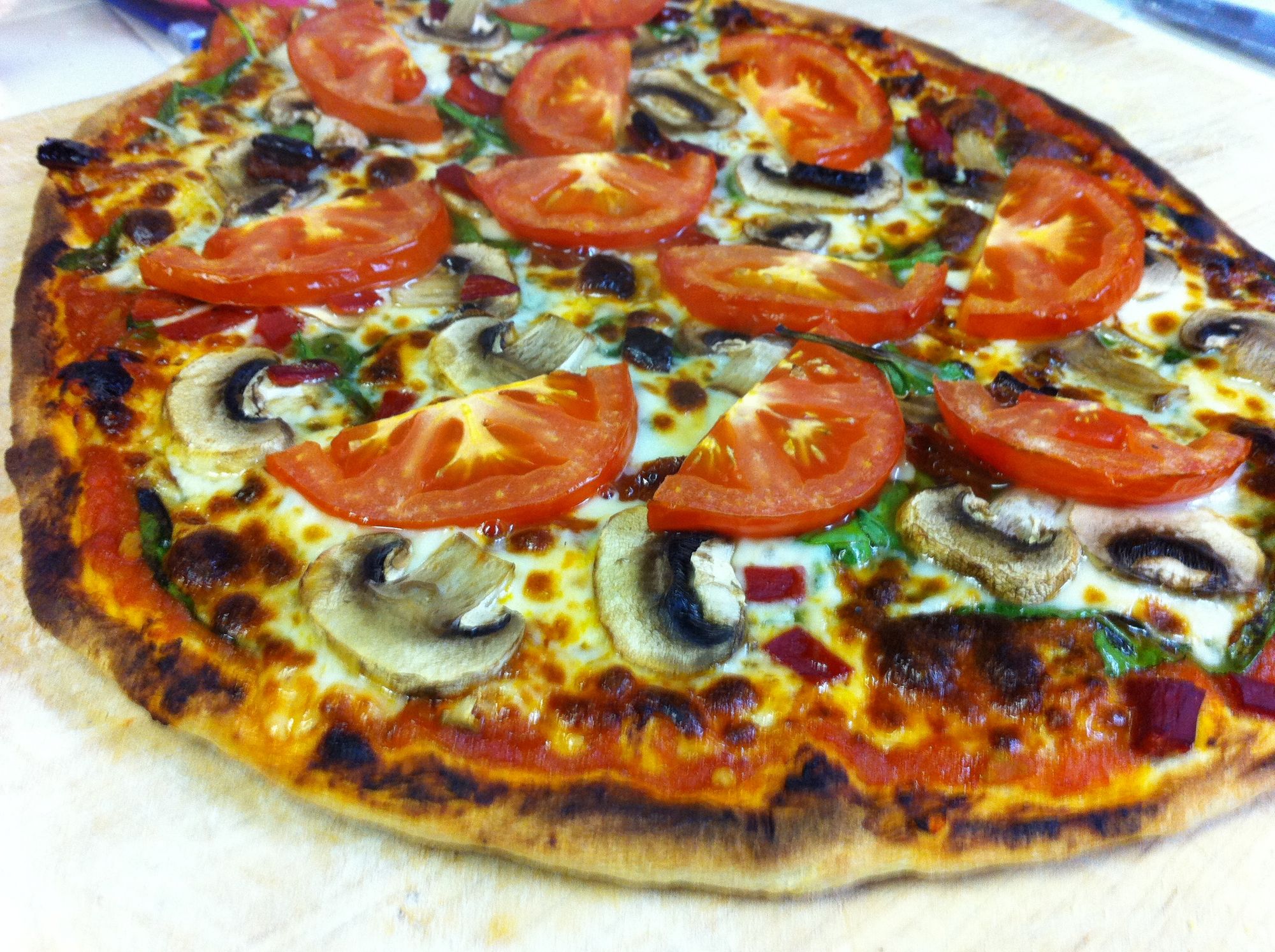
For the first pizza I made on The Baking Steel, I had the steel on the bottom rack. I heated the oven & steel for an hour at the hottest temp the oven can muster. I ended up baking the pizza for 10 minutes. It came out really well. The dough was not soggy at all, and it was well-cooked. There was a nice char on the rim of the crust, and the cheese browned nicely, but I did not get as much “oven spring” as I wanted.
If I recall correctly, the first three pizzas I made on the steel all had the same toppings (in this order): sauce, fresh spinach, sliced Portabello mushrooms, whole milk Mozzarella cheese, and sliced tomatoes.
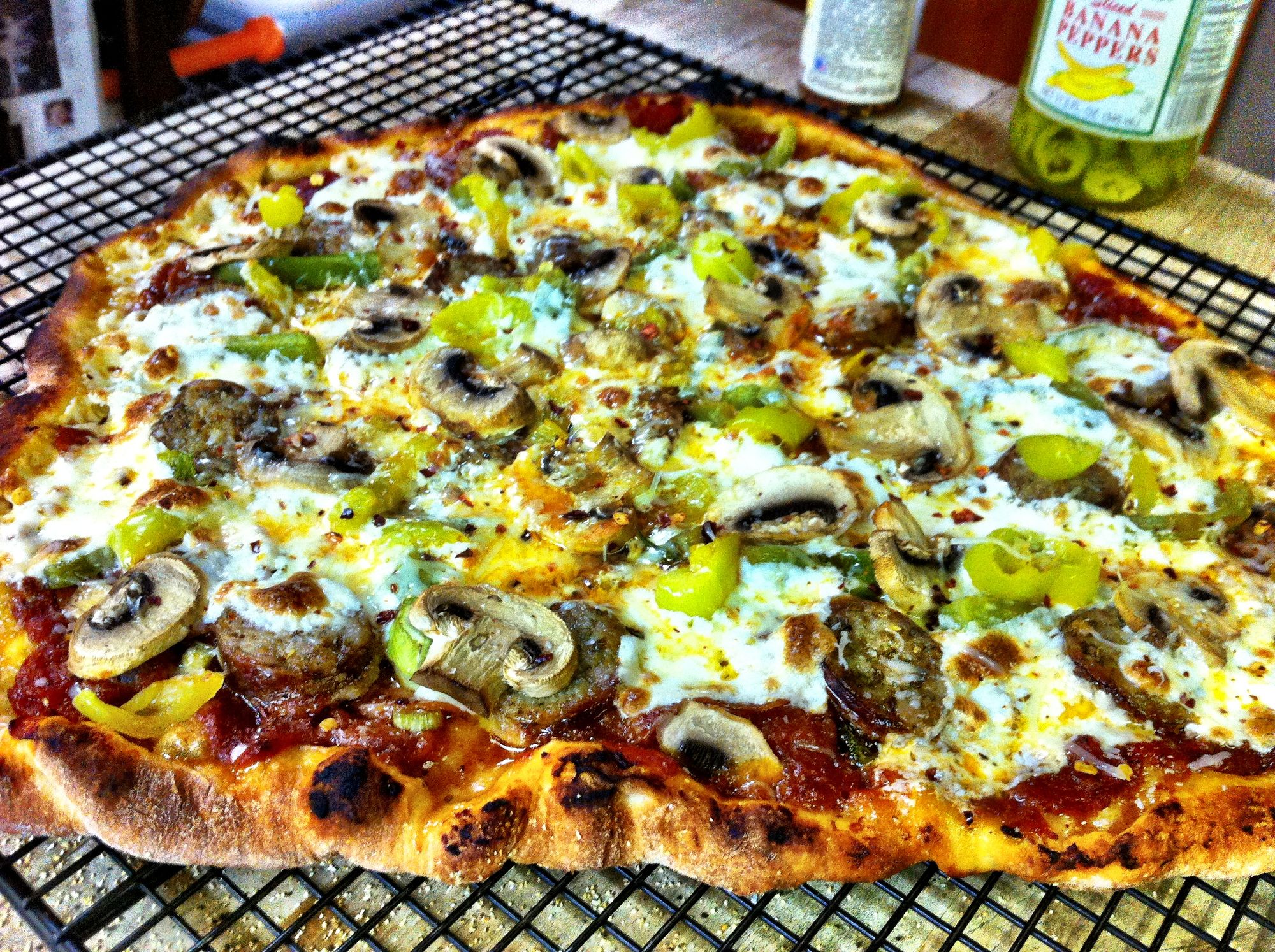
For the second pizza I tried to follow Kenji’s (at The Pizza Lab at SeriousEats.com) “steel and broiler” method (even down to the metal spoon holding open the oven door slightly). For this method, I heated the steel on the second-to-top rack in the oven, and just before sliding the pizza onto the stone, I switched the oven from Bake to Broil. I ended up pulling the pizza at 5 minutes because it looked done. But it was not. The outer crust had charred, but it really did not cook in the middle. I ended up putting it back in the oven after I had sliced it. I heated it up for another 4 minutes. It turned out fine.
Lesson learned? The broiler method may have worked for my oven if I had the steel one more rack down from the broiler. [I am making a note to try this next time I make pizzas.]
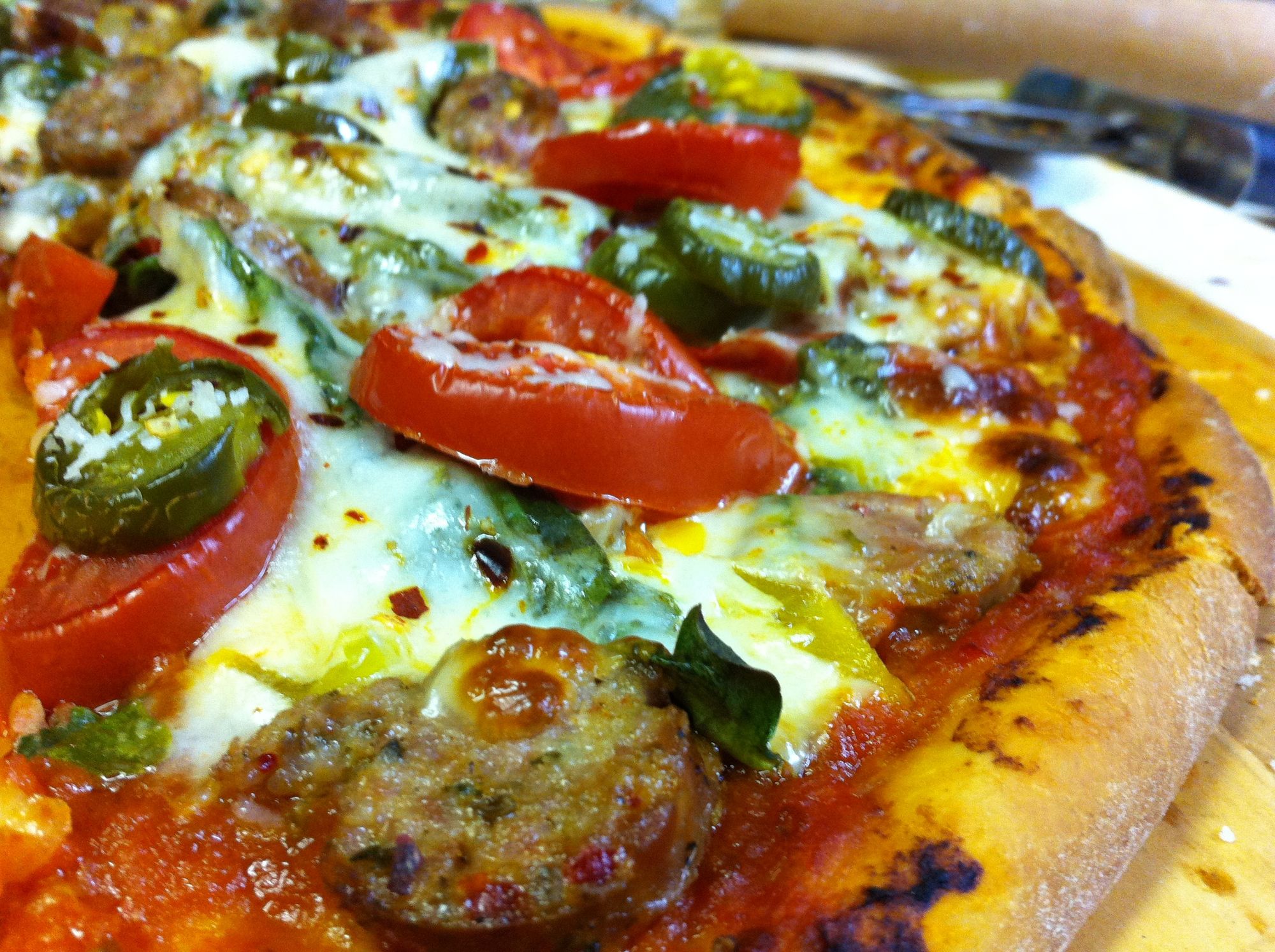
For the third pizza, I riffed on Kenji’s “steel and broiler” method. I kept the steel on the rack second-from-the-top, and I first baked the pizza for 3 minutes. I kept a metal spoon in the door to force it open slightly, which prevents the heating element from shutting off a the max temperature. Then I turned the broiler on for 4 minutes, and then turned the oven back to Bake, closed the oven door all the way, and left the pizza in for another 2 minutes. It came out better than pizza #2, but I still feel like it could have cooked a little more.
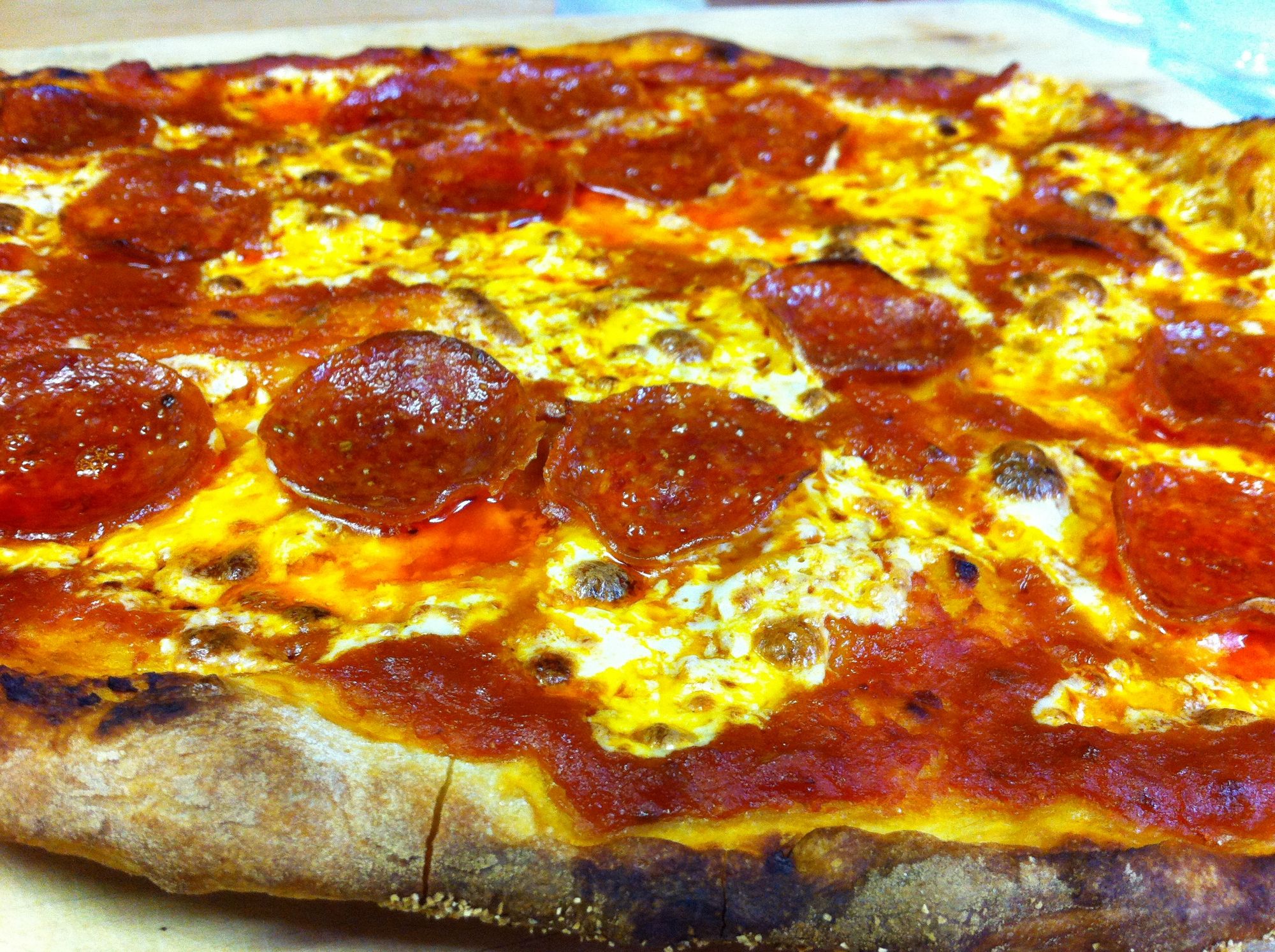
For pizza #4 I used Kenji’s “steel and stone” method. I heated the steel on the bottom rack in the oven. And on the rack right above it, I heated my baking stone. So, when I put the pizza on the steel, it was basically “sandwiched” between two very hot elements. This method is similar to the “steel and broiler” method, but it diffuses the heat on top. In other words, the heat is not as harsh as the heat coming from the broiler.
For my oven, this last method worked the best. Steel and stone. And for the last three pizzas I made, I just tried to perfect this method. One trick that Andris recommended was to limit the number of toppings. In doing so, I obtained a much greater oven spring in the crust.
MY VERDICT?
No comparison. The Baking Steel blows my baking stone out of the water. It transforms my sad oven into an oven that can produce a crisp, well-baked pizza in less than 10 minutes. And it does so without necessitating a pre-bake of the crust. What a time saver! The Baking Steel also produced a char and “cheese burn” that I have never been able to achieve with a baking stone.
The Baking Steel is a clear winner. Hands down.
THE INTERVIEW WITH ANDRIS LAGSDIN, FOUNDER OF THE BAKING STEEL
You can listen to the interview in its entirety by clicking the play button below or up at the top of this page… just below the title of this article. As a matter of fact, you can play it in a new window and continue surfing the web while you listen. 😉
Of course, you can also just download the file from iTunes by clicking HERE.
WHAT ABOUT YOU?
What are your thoughts on The Baking Steel and the discoveries that I have made as a home pizza chef? I’d love to hear your thoughts. Leave a comment below!
To leave feedback for the Catholic Foodie, call 985-635-4974 and leave a message. You can also leave feedback for me at jeff@catholicfoodie.com.
Download episode 144 here or listen to it below: